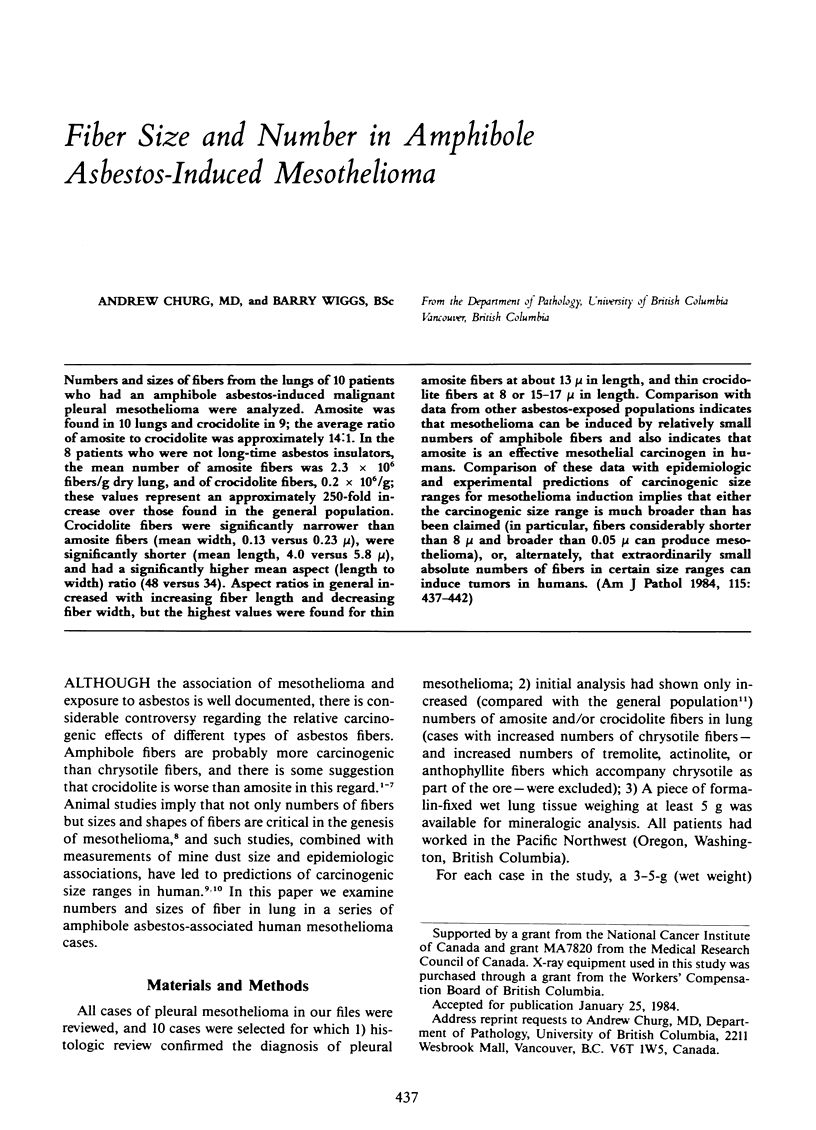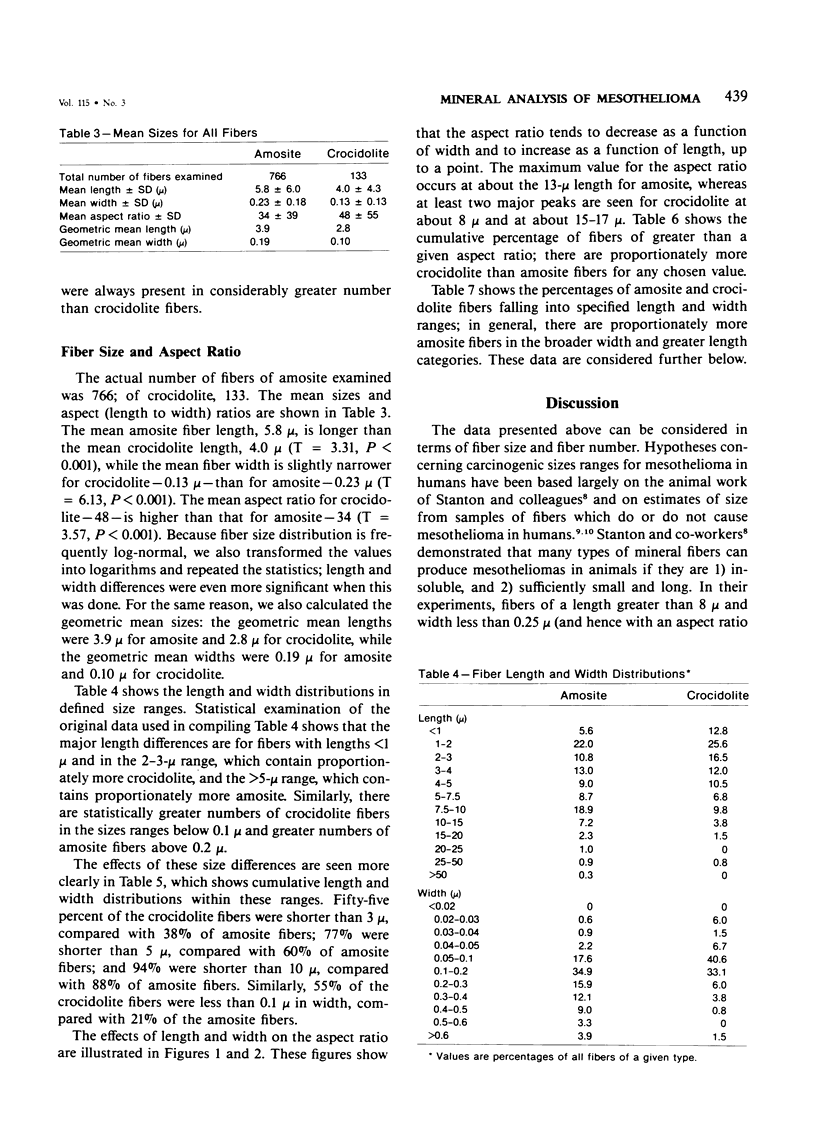Abstract
Numbers and sizes of fibers from the lungs of 10 patients who had an amphibole asbestos-induced malignant pleural mesothelioma were analyzed. Amosite was found in 10 lungs and crocidolite in 9; the average ratio of amosite to crocidolite was approximately 14:1. In the 8 patients who were not long-time asbestos insulators , the mean number of amosite fibers was 2.3 X 10(6) fibers/g dry lung, and of crocidolite fibers, 0.2 X 10(6)/g; these values represent an approximately 250-fold increase over those found in the general population. Crocidolite fibers were significantly narrower than amosite fibers (mean width, 0.13 versus 0.23 mu), were significantly shorter (mean length, 4.0 versus 5.8 mu), and had a significantly higher mean aspect (length to width) ratio (48 versus 34). Aspect ratios in general increased with increasing fiber length and decreasing fiber width, but the highest values were found for thin amosite fibers at about 13 mu in length, and thin crocidolite fibers at 8 or 15-17 mu in length. Comparison with data from other asbestos-exposed populations indicates that mesothelioma can be induced by relatively small numbers of amphibole fibers and also indicates that amosite is an effective mesothelial carcinogen in humans. Comparison of these data with epidemiologic and experimental predictions of carcinogenic size ranges for mesothelioma induction implies that either the carcinogenic size range is much broader than has been claimed (in particular, fibers considerably shorter than 8 mu and broader than 0.05 mu can produce mesothelioma), or, alternately, that extraordinarily small absolute numbers of fibers in certain size ranges can induce tumors in humans.
Full text
PDF





Selected References
These references are in PubMed. This may not be the complete list of references from this article.
- Acheson E. D., Bennett C., Gardner M. J., Winter P. D. Mesothelioma in a factory using amosite and chrysotile asbestos. Lancet. 1981 Dec 19;2(8260-61):1403–1406. doi: 10.1016/s0140-6736(81)92813-0. [DOI] [PubMed] [Google Scholar]
- Acheson E. D., Gardner M. J., Pippard E. C., Grime L. P. Mortality of two groups of women who manufactured gas masks from chrysotile and crocidolite asbestos: a 40-year follow-up. Br J Ind Med. 1982 Nov;39(4):344–348. doi: 10.1136/oem.39.4.344. [DOI] [PMC free article] [PubMed] [Google Scholar]
- Ashcroft T., Heppleston A. G. The optical and electron microscopic determination of pulmonary asbestos fibre concentration and its relation to the human pathological reaction. J Clin Pathol. 1973 Mar;26(3):224–234. doi: 10.1136/jcp.26.3.224. [DOI] [PMC free article] [PubMed] [Google Scholar]
- Berry G., Newhouse M. L. Mortality of workers manufacturing friction materials using asbestos. Br J Ind Med. 1983 Feb;40(1):1–7. doi: 10.1136/oem.40.1.1. [DOI] [PMC free article] [PubMed] [Google Scholar]
- Churg A. Asbestos fiber content of the lungs in patients with and without asbestos airways disease. Am Rev Respir Dis. 1983 Apr;127(4):470–473. doi: 10.1164/arrd.1983.127.4.470. [DOI] [PubMed] [Google Scholar]
- Churg A. Asbestos fibers and pleural plaques in a general autopsy population. Am J Pathol. 1982 Oct;109(1):88–96. [PMC free article] [PubMed] [Google Scholar]
- Churg A., Warnock M. L. Asbestos fibers in the general population. Am Rev Respir Dis. 1980 Nov;122(5):669–678. doi: 10.1164/arrd.1980.122.5.669. [DOI] [PubMed] [Google Scholar]
- Harington J. S. Fiber carcinogenesis: epidemiologic observations and the Stanton hypothesis. J Natl Cancer Inst. 1981 Nov;67(5):977–989. [PubMed] [Google Scholar]
- McDonald A. D., Fry J. S. Mesothelioma and the fiber type in three American asbestos factories - preliminary report. Scand J Work Environ Health. 1982;8 (Suppl 1):53–58. [PubMed] [Google Scholar]
- McDonald A. D., McDonald J. C. Mesothelioma after crocidolite exposure during gas mask manufacture. Environ Res. 1978 Dec;17(3):340–346. doi: 10.1016/0013-9351(78)90038-5. [DOI] [PubMed] [Google Scholar]
- McDonald A. D., McDonald J. C., Pooley F. D. Mineral fibre content of lung in mesothelial tumours in North America. Ann Occup Hyg. 1982;26(1-4):417–422. [PubMed] [Google Scholar]
- McDonald J. C., Liddell F. D., Gibbs G. W., Eyssen G. E., McDonald A. D. Dust exposure and mortality in chrysotile mining, 1910-75. Br J Ind Med. 1980 Feb;37(1):11–24. doi: 10.1136/oem.37.1.11. [DOI] [PMC free article] [PubMed] [Google Scholar]
- Selikoff I. J., Seidman H., Hammond E. C. Mortality effects of cigarette smoking among amosite asbestos factory workers. J Natl Cancer Inst. 1980 Sep;65(3):507–513. [PubMed] [Google Scholar]
- Stanton M. F., Layard M., Tegeris A., Miller E., May M., Morgan E., Smith A. Relation of particle dimension to carcinogenicity in amphibole asbestoses and other fibrous minerals. J Natl Cancer Inst. 1981 Nov;67(5):965–975. [PubMed] [Google Scholar]
- Wagner J. C., Berry G., Pooley F. D. Mesotheliomas and asbestos type in asbestos textile workers: a study of lung contents. 1982 Aug 28-Sep 4Br Med J (Clin Res Ed) 285(6342):603–606. doi: 10.1136/bmj.285.6342.603. [DOI] [PMC free article] [PubMed] [Google Scholar]
- Wagner J. C., Pooley F. D., Berry G., Seal R. M., Munday D. E., Morgan J., Clark N. J. A pathological and mineralogical study of asbestos-related deaths in the United Kingdom in 1977. Ann Occup Hyg. 1982;26(1-4):423–431. [PubMed] [Google Scholar]


